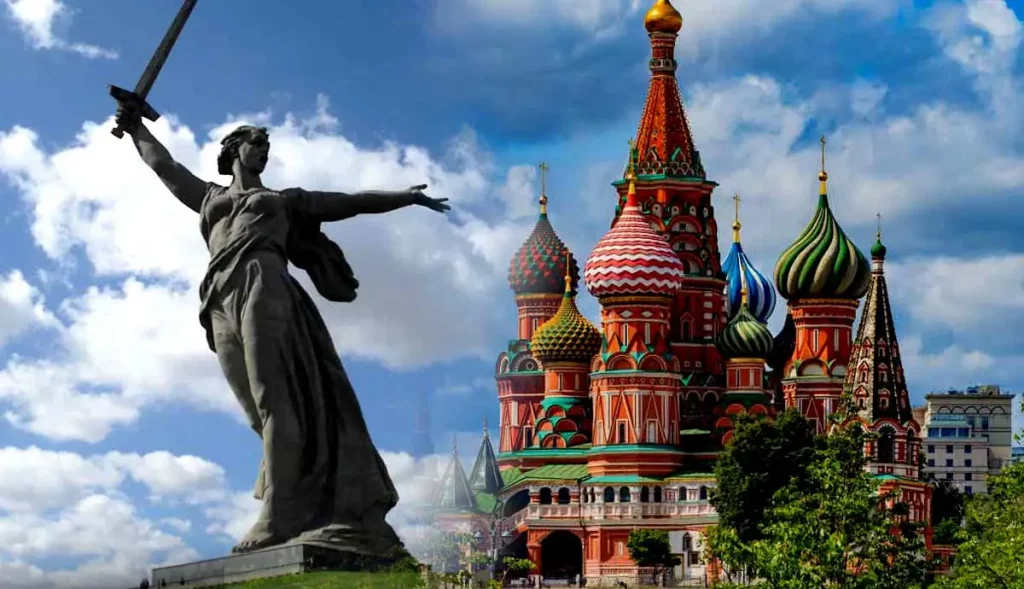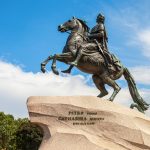Russia, with its rich history and diverse cultural heritage, is home to a plethora of iconic monuments that stand as testaments to its grandeur and resilience. From majestic cathedrals and fortified kremlins to towering statues and monumental memorials, Russian monuments encapsulate the nation’s tumultuous past, artistic prowess, and enduring spirit. In this article, we embark on a journey to explore some of the most iconic Russian monuments, each with its own story to tell and its own place in the hearts of the Russian people.
- Saint Basil’s Cathedral, Moscow:
Standing proudly at the heart of Moscow’s Red Square, Saint Basil’s Cathedral is one of Russia’s most recognizable landmarks and a symbol of the country’s architectural brilliance. Built in the 16th century under the reign of Ivan the Terrible, this masterpiece of Russian architecture is renowned for its vibrant colors, intricate onion domes, and whimsical design. Comprising nine chapels arranged around a central core, each adorned with distinctive patterns and motifs, Saint Basil’s Cathedral is a true marvel of creativity and craftsmanship. - The Kremlin, Moscow:
The Kremlin, a fortified complex overlooking the Moskva River, is not only the seat of Russian power but also a living testament to the nation’s history and heritage. Dating back to the 12th century, the Kremlin has served as the residence of Russian tsars, the center of Orthodox Christianity, and the stronghold of Russian sovereignty. Within its walls lie an array of architectural treasures, including the stunning Cathedral of the Assumption, the imposing Ivan the Great Bell Tower, and the iconic Kremlin Palace. Today, the Kremlin remains a symbol of Russian authority and a UNESCO World Heritage Site, attracting visitors from around the globe. - The Hermitage Museum, Saint Petersburg:
Housed within the opulent Winter Palace in Saint Petersburg, the Hermitage Museum is one of the largest and most prestigious art museums in the world. Boasting a vast collection of over three million artworks spanning millennia and continents, the Hermitage is a cultural treasure trove that showcases the splendor of Russian art and history. From priceless masterpieces by Rembrandt, Leonardo da Vinci, and Michelangelo to ancient artifacts, decorative arts, and imperial regalia, the Hermitage offers a glimpse into the richness and diversity of Russian culture. - Peter and Paul Fortress, Saint Petersburg:
Perched on the banks of the Neva River, the Peter and Paul Fortress is a formidable bastion of Russian military might and a symbol of the city’s founding by Peter the Great in 1703. Originally built to defend the fledgling city from Swedish invaders, the fortress later served as a political prison and a center of scientific innovation. Today, the Peter and Paul Fortress is home to the iconic Peter and Paul Cathedral, the final resting place of Russian tsars and tsarinas, including Peter the Great himself. With its towering spire and gilded angel, the cathedral is a striking symbol of Russian imperial power and religious devotion. - The Motherland Calls, Volgograd:
Standing atop the Mamayev Kurgan memorial complex in Volgograd, formerly known as Stalingrad, The Motherland Calls is a monumental statue that commemorates the sacrifices of the Soviet Union during World War II. Designed by sculptor Yevgeny Vuchetich and engineer Nikolai Nikitin, this colossal statue depicts a sword-wielding woman towering over the battlefield, urging her compatriots to defend their homeland. At 85 meters tall, The Motherland Calls is one of the tallest statues in the world and a poignant reminder of the courage and resilience of the Russian people in the face of adversity. - Church of the Savior on Spilled Blood, Saint Petersburg:
Inspired by the iconic St. Basil’s Cathedral in Moscow, the Church of the Savior on Spilled Blood is a breathtaking example of Russian Revival architecture and a tribute to the memory of Emperor Alexander II, who was assassinated on the site in 1881. Adorned with colorful onion domes, elaborate mosaics, and intricate stone carvings, the church is a feast for the eyes and a testament to the skill and craftsmanship of Russian artisans. Today, the Church of the Savior on Spilled Blood stands as a symbol of remembrance and reconciliation, welcoming visitors from around the world to marvel at its beauty and pay homage to its tragic history. - Monument to Minin and Pozharsky, Moscow:
Located in front of Saint Basil’s Cathedral in Red Square, the Monument to Minin and Pozharsky commemorates the heroic efforts of Prince Dmitry Pozharsky and merchant Kuzma Minin in defending Russia against Polish invaders during the Time of Troubles in the early 17th century. Designed by sculptor Ivan Martos and unveiled in 1818, the monument depicts Minin and Pozharsky rallying their fellow countrymen to take up arms and defend their homeland. A symbol of patriotism and unity, the Monument to Minin and Pozharsky stands as a testament to the indomitable spirit of the Russian people in times of crisis.
Russian monuments are more than just architectural marvels; they are living symbols of the nation’s history, culture, and identity. From the majestic cathedrals of Moscow to the solemn memorials of Volgograd, each monument tells a story of triumph, tragedy, and resilience that resonates with visitors from around the world. As guardians of Russia’s past and beacons of its future, these iconic landmarks inspire awe, reverence, and reflection, reminding us of the enduring spirit of the Russian people and the timeless beauty of their homeland.

